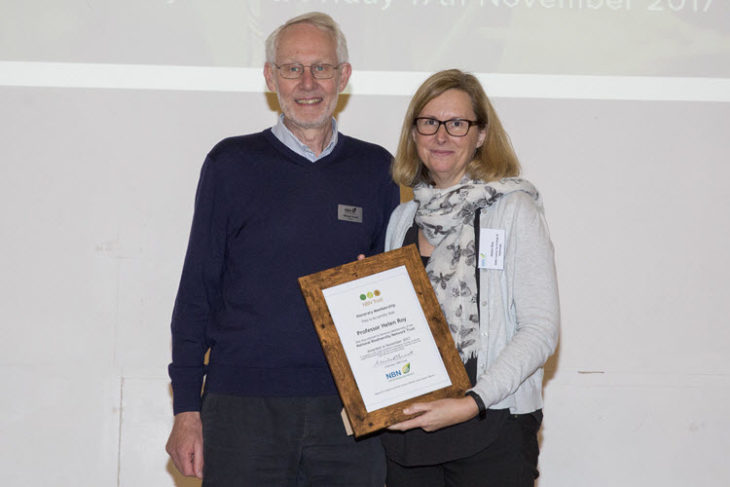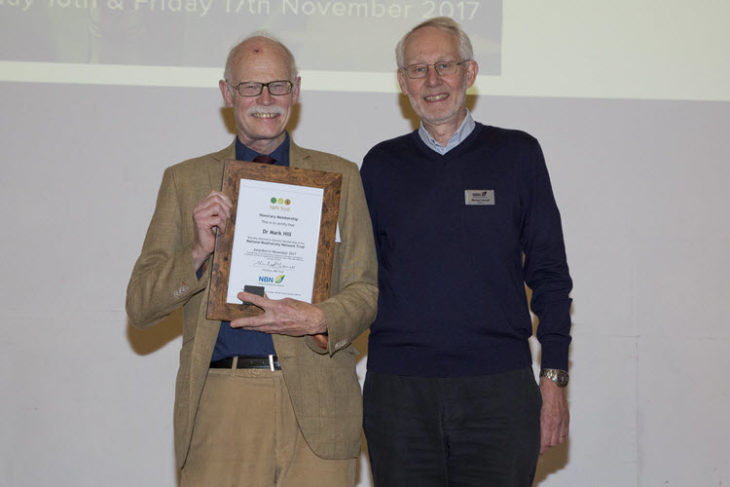As part of the NBN Conference in Cardiff we were delighted to bestow Honorary Membership upon Dr Mark Hill and Professor Helen Roy.
Professor Helen Roy of Biological Records Centre CEH Wallingford
Helen Roy was given Honorary Membership of the NBN Trust to recognise her unique contribution to biological recording since having taken on the running of the Ladybird Recording Scheme, as well as recognising her important role in the wider NBN data-provision process.
While her professional role at CEH Wallingford has inevitably ensured that her work is central to the acquisition of biological data, in particular, for use within the NBN, we would especially want to draw attention to her extra-curricular work. She supports a wide range of biological recording activities, and is a great advocate, especially through ladybird monitoring encouraging engagement with ‘citizen science’.
Over the last ten years or more, she has been a tireless enthusiast for pubic engagement in biological recording. She has pioneered development of online recording, and been a primary advocate at meetings, conferences and public engagement events. She has championed the uptake of modern systems of recording, particularly iRecord and its associated developments. Her high public profile, especially in the area of insect recording, has benefited the NBN through engaging with very disparate groups of people.
Her academic work has also demonstrated to a wide audience, and not just academics, the value of broad-scale NBN data in analyses of biodiversity functions and impacts. She has an enthusiastic willingness to share her insights with a wide range of people, amateur as well as professional. This has included frequent engagement internationally with other scientists, especially developing standards and analytical methods relating to biological recording and the data it produces.
Her advocacy for, and support of the NBN’s long-term aims has been crucial in maintaining engagement with the NBN through a period of change, when so much especially invertebrate data might not have made its way to the NBN Gateway and more recently the NBN Atlas.

Dr Mark Hill
Mark has been recording bryophytes for over 50 years in association with the British Bryological Society, which he joined in 1965. For much of this time he worked as a professional ecologist and his recording was a spare-time activity.
He was appointed head of the Biological Records Centre in 2003 and from then until (and beyond) his retirement in 2010 he made major contributions to the techniques for analysing biological records.
Mark’s recording of bryophytes is reflected by his 48,580 records (including determinations and confirmations of specimens collected by others) which are freely available on the NBN Atlas at full resolution; there are probably at least as many more which have been made on local or national field meetings and are therefore not credited to him personally.
He has been a key member of the Cambridgeshire BBS group since 1986, enthusiastically running its excursions and the BBS week-long meetings. He acted as BBS recorder of Mosses between 1977 and 1986, vetting all new vice-county records, and even those whose records were rejected as misidentifications were usually encouraged by his prompt and cheerful letters.
Mark has been co-author of the three most recent bryophyte checklists and census catalogues covering Britain and Ireland (1981, 1998, 2008). He was one of several British authors who produced a checklist of European mosses in 1981, and in 2006 he led a group of European authors to produce an updated checklist. He is also our national expert on the large and important genus Sphagnum, contributing the accounts to the standard flora and writing a field guide (1992) which was at one stage JNCC’s best-selling publication. These publications, and his informal tuition on many meetings, have done much to make this group, hitherto thought of as difficult, much more accessible to British and Irish bryologists.
Mark’s enthusiasm was instrumental in ensuring the successful publication of the first BBS bryophyte atlas (1991-94). Mark was appointed BBS Recording Secretary in 2004, at a stage when the Society had scarcely engaged with the computerisation of records. He helped this transition by devising practical tools, such as an electronic recording card which provided an easy way to input records, and set up standard procedures for vetting incoming records. He was a joint author of the proposal for a new BBS atlas and processed some 1,959,888 records during the run-up to its publication (2014), a massive personal commitment of time and expertise.
Always an advocate of making data openly available, he welcomed the development of the NBN Gateway and considered that it should display the BBS data in full. The easy acceptance by BBS of the recent transition to the NBN Atlas owes much to his influence over many years.
While head of BRC, and in his prior role within CEH, Mark developed techniques for the analysis of biological records. His papers have devised methods to analyse the patterns of occurrence of flowering plants in Europe and of both flowering plants and bryophytes in Britain and Ireland, and to tease out the relative importance of air pollution, habitat loss and climate change in the changing distribution of British flowering plants and bryophytes. He often led the field in the use of biological records to address environmental issues – he worked on the impacts of climate change in the early 1990s and non-native
species in the late 1990s, before both fields became ‘fashionable’ and the focus of numerous research projects. For example, Mark led an audit of all non-native species in England in 2005, extending this to Great Britain in 2010. A particularly notable contribution has been the program FRESCALO (2012), devised to identify trends in species frequency using biological recording data. This has subsequently been applied to both plant and animal groups both in Britain and elsewhere in western Europe.

